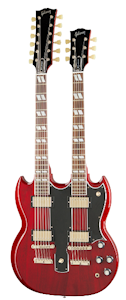
The Gibson EDS-1275 is a unique and iconic double-neck electric guitar produced by Gibson Guitar Corporation. It gained popularity for its distinctive design and versatility, allowing guitarists to switch between six-string and twelve-string configurations on a single instrument.
The EDS-1275 was introduced by Gibson in 1958. The "EDS" in the name stands for "Electric Double Spanish." Catalogs called it the "Double 12". The guitar was intended to cater to the needs of guitarists seeking a versatile instrument capable of producing a wide range of sounds.
Early Design: The initial design of the EDS-1275 in 1957 featured a semi-hollow body and a 12-string/6-string neck combo, with dual PAF humbuckers for each.
Evolution in the 1960s: In the early 1960s, Gibson redesigned the EDS-1275. Starting in 1962, the guitar had a solid mahogany body and a set neck construction. Although similar in shape to the Gibson SG, the EDS-1275 body does not feature the pronounced curvature of the SG's horns. It became popular among rock guitarists looking for a single instrument capable of covering both rhythm and lead guitar duties.
Influential Performances: The EDS-1275 gained significant attention and recognition when it was used by prominent guitarists in various musical genres. One of the most notable early adopters was blues-rock legend Jimmy Page of Led Zeppelin, who used the double-neck guitar extensively during live performances, most notably in the song "Stairway to Heaven."
Popularity and Cultural Impact: Throughout the 1970s and beyond, the EDS-1275 continued to be sought after by guitarists in various genres, including rock, hard rock, and progressive rock. Its distinctive appearance and versatility made it an iconic symbol of rock music. Other notable artists who used the EDS-1275 include Alex Lifeson of Rush, Don Felder of Eagles, and Slash of Guns N' Roses.
Other Gibson Double-Neck Configurations:
- As early as 1937, Gibson had made the ESH-150, a solid-body 6-string guitar/8-string lap steel combo.
- The 1957 EMS-1235 featured an 8-string mandolin/6-string guitar duo with a semi-hollow body with double binding.
- The EBS-1250 (1962-1968, 1977-1978) featured 4-string bass and 6-string guitar necks, The EBSF-1250 added a built-in fuzztone.
- The EMS-1275 Octave featured two 6-string guitar necks, one with a scale short enough that it could be tuned an octave higher than the other.
Modern Production: Gibson has continued to produce the EDS-1275 in various iterations over the years. The guitar has seen refinements in its design, construction, and electronics. Modern versions often feature a solid mahogany body, mahogany necks, rosewood fingerboards, and Gibson's own humbucking pickups.
Collector's Item: Due to its historical significance and association with legendary guitarists, vintage EDS-1275 guitars have become highly collectible. Original models from the late 1950s and early 1960s, especially those in good condition, command high prices in the vintage guitar market.
The Gibson EDS-1275 remains an iconic and sought-after instrument, loved by guitarists for its unique design and ability to produce a wide range of sounds. Its place in rock music history is firmly established, and it continues to be a symbol of versatility and craftsmanship in the world of electric guitars.
